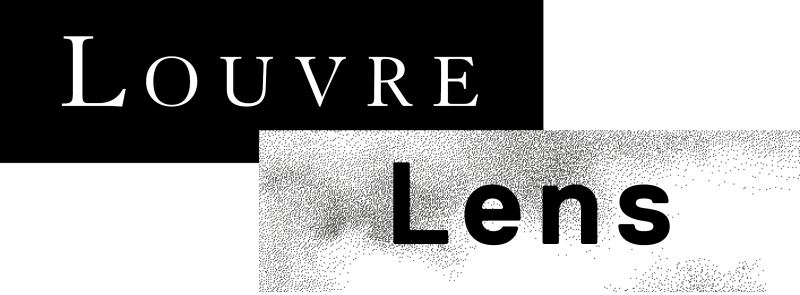This website uses cookies so that we can provide you with the best user experience possible. Cookie information is stored in your browser and performs functions such as recognising you when you return to our website and helping our team to understand which sections of the website you find most interesting and useful.
The exhibition offers two itineraries that open out onto each other. The first recounts a succession of encounters and shared stories, from the artist’s first visit to the Louvre in 1900 up until the 21st century. The second is an invitation to immerse oneself in his work in rooms that evoke the Louvre’s departments. The comparison of works by the Spanish master with ones from the museum’s collections reveals the prolific dialogue that developed over decades between two iconic figures from the history of art, the Louvre and Picasso.
Two full-length portraits greet visitors seeking to learn about Picasso from the perspective of the Louvre and the Louvre from the perspective of Picasso. The artist, aged 19, is portrayed by his friend Ramon Casas during his first trip to Paris in 1900. It hangs next to an aerial photograph of the museum, taken a few years later, which also takes the form of a standing figure. These two extraordinary beings, similar in many respects, here stand face to face, or rather side by side.
A gallery of postcards belonging to Picasso showing the Louvre and some of its masterpieces and a series of documents from the museum’s archives showing works by the artist recount the role that each occupied in their respective histories.
Publications, press cuttings, correspondence, invitation cards, photographs: throughout his life the artist collected and kept numerous items linked to the Louvre, to its history, its collections and his relations with some of its representatives. Similarly, Picasso’s presence in the Louvre’s research centres and libraries reveals the attention that the artist received over time.
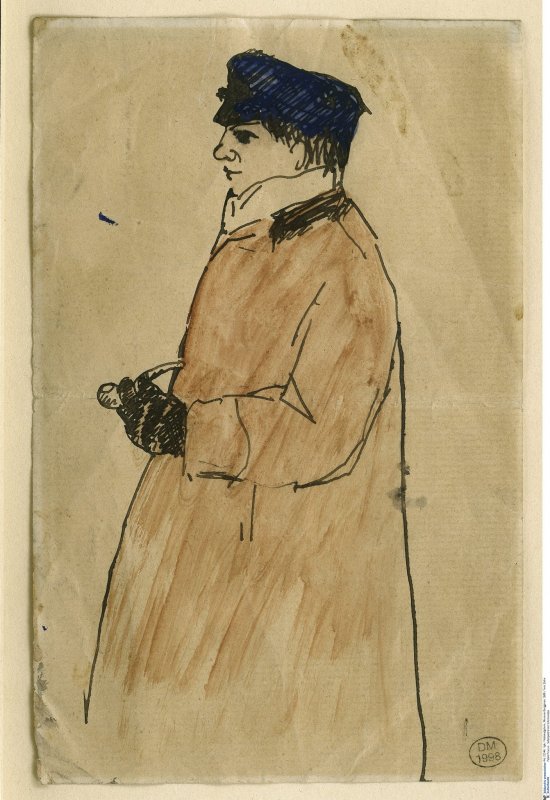
Pablo Picasso Autoportrait à la pipe ; Autoportrait à la casquette 1904 – 1905 Dessin H. :39,5cm, L. :32cm, P. :3cm Staatliche Museen zu Berlin, Nationalgalerie, Museum Berggruen © Succession Picasso 2021 © BPK, Berlin, Dist. RMN-Grand Palais / Jens Ziehe © Succession Picasso 2021
© BPK, Berlin, Dist. RMN-Grand Palais / Jens Ziehe
First itinerary | Chronology of the Louvre-Picasso relationship: 1900–2021
First trips to the Louvre
The exhibition opens with the evocation of Picasso’s very first trips to the Louvre, in 1900, through accounts by friends or biographers, at a time when the Exposition Universelle, in which he participated, was taking place nearby. Before April 1904, when he settled for good in Paris, he made several trips to France and took advantage of each one to visit the museum, where he discovered the collections of Egyptian antiquities, Greek and Roman antiquities and Near Eastern antiquities. He was also interested in the paintings of Nicolas Poussin (1594–1665) and Jean-Auguste-Dominique Ingres (1780–1867).
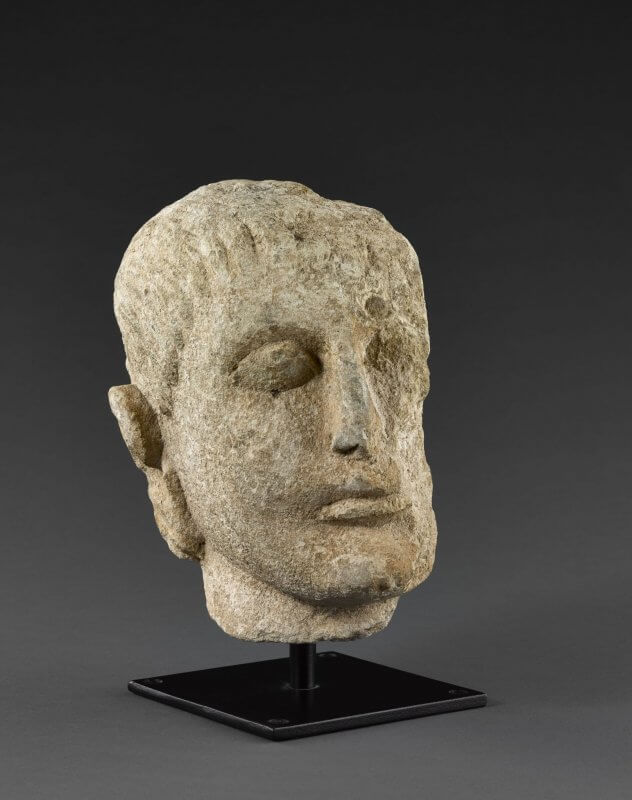
Sculpture ibérique tête masculine ; volée par Géry Piéret en 1907 3e siècle avant J.-C. Calcaire 20 x 17,5 x 13 cm Paris, musée du Louvre, département des Antiquités orientales © RMN-Grand Palais (musée d’Archéologie nationale) / Franck Raux
The affair of the statuettes and the failed acquisition
Things started off with a bang. In 1911, the affair of the theft of the Mona Lisa broke out, an act that Géry Piéret (1884–1918 ?), the former secretary of the poet Guillaume Apollinaire, wrongly boasted of having carried out. However, four years earlier, he had stolen from the Louvre two Iberian statuettes: one was sold to Picasso, the other given to him. Panicked by the announcement of the theft of the Mona Lisa, Apollinaire and Picasso decided to give back the statuettes anonymously via the offices of the Paris-Journal. Suspected of complicity in the theft, Apollinaire was locked up for a few days, and Picasso was questioned before both of them were finally found to be innocent.
This affair reveals the artist’s interest in ancient cultures.
In 1935, a second disappointment revealed another, more unexpected facet, of Picasso’s tastes. The department overseeing the Louvre’s objets d’art made an exceptional acquisition from the antiques dealer Jacques Helft, a pair of andirons for a fireplace by François-Thomas Germain, metalsmith at the court of Louis XV. According to Helft, Picasso had long coveted these two masterpieces, dating from 1757, one of which is on display in the exhibition.
A first Picasso canvas at the Louvre
In 1933, a painting by Picasso briefly entered the Louvre for the first time. This was Portrait of the Art Critic Gustave Coquiot (1901, Paris, Centre Pompidou), the first work by the artist to be purchased for the French public collections. At this time, all state acquisitions were examined at the Salle du Conseil des Musées Nationaux, located in the museum’s Mollien wing. This portrait, today conserved in the Musée National d’Art Moderne, initiated the long series of works by Picasso that were soon submitted to the experts there responsible for ruling on opportunities to enrich the national collections.
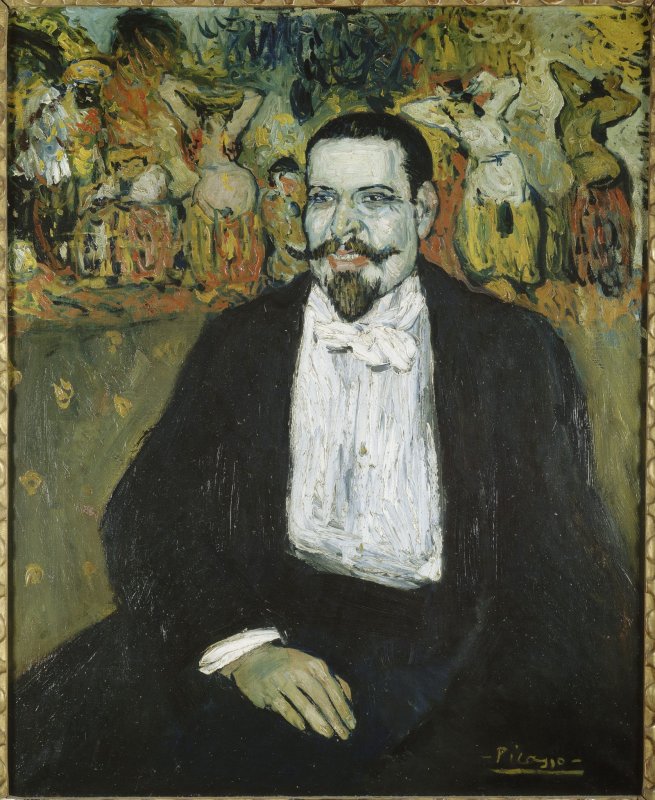
© Succession Picasso 2021 © Centre Pompidou, MNAM-CCI, Dist. RMN-Grand Palais-Béatrice Hatala
Picasso: history intervenes (1939–1945)
Threats of pillage or destruction at the onset of the Second World War formed another facet of the story shared by the Louvre and the Picasso. In September 1938, fearing that war was imminent, the Louvre was actively working on evacuating its treasures to the provinces, as well as those of a certain number of collectors. In this context, Paul Jamot, former head of the Louvre’s Department of Paintings, entrusted much of his collection to the Louvre, including in particular two drawings by Picasso, Woman with a Large Hat (1901) and The Vagabond (1901).
From October 1940 to August 1944, several ‘sequester’ rooms at the Louvre were requisitioned by the occupying Nazis. There they stored and inventoried goods stolen from Jewish collectors and dealers who had sought refuge abroad or been deported. Thus, during the war, tens of works by Picasso passed through the Louvre sequestration, such as the Woman’s Bust (1906–1907, Berlin, Berggruen Museum), which was confiscated with the rest of his possessions from the art lover Alphonse Kann. The work was inventoried by the Nazis under the number ‘Ka 1103’ and returned to the collector’s niece in 1948, a month after his death.
Links with Louvre curators, between imagination and scepticism
Picasso aroused strong feelings among the Louvre’s curators, and throughout his life the artist developed more or less close relations with some of them. Germain Bazin and René Huyghe, for example, recognised his genius, but criticised him in particular, sometimes vehemently, for the unforgivable distortions that he imposed on the human figure.
Georges Salles, director of the Musées de France from 1945 to 1957 and former curator at the Louvre, a specialist in Asian arts, collector and ardent defender of the art of his time, established very close links with Picasso. An admirer of the man and his art, he owned, throughout his lifetime, around thirty of his works, several of which adorned the walls of his office and his private apartment at the Louvre. In 1952, Picasso offered to paint Salles’s portrait. The latter was attracted to the idea that the work might, during his own lifetime, be hung at the Louvre, ‘in the board of directors’ antechamber’. However, this project for a portrait initiated by Picasso never got further than the stage of preparatory sketches. This might have been because Salles did not ask him to paint a ceiling at the Louvre, as he had Georges Braque (1882–1963).
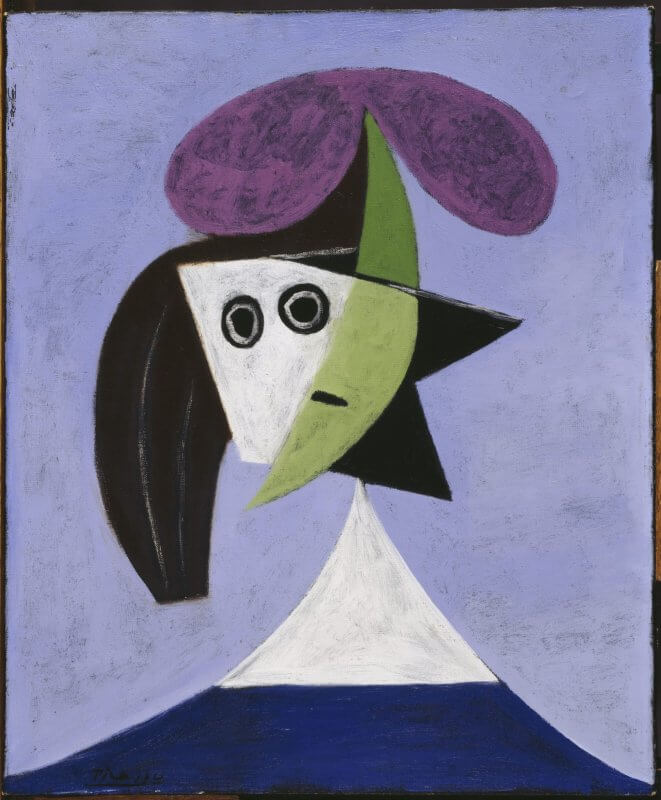
© Succession Picasso 2021 © Centre Pompidou, MNAM CCI, Dist. RMN Grand Palais-Georges Meguerditchian
Physical proximity with the works at the Louvre: Michelangelo’s Slaves
Several anecdotes testify to the Louvre’s omnipresence in Picasso’s artistic and personal life.
Between September and November 1946, Picasso set up a studio in the Musée d’Antibes, in the large room that the curator Romuald Dor de la Souchère put at his disposal. The artist left the works he created there to the museum and these were quickly put on display, alongside plaster casts representing Michelangelo’s Slaves (1513), conserved at the Louvre. Around twenty years later, these casts, which Picasso was particularly fond of, were given to him by Dor de la Souchère. Numerous photographs show the Rebellious Slave and the Dying Slave in Picasso’s sculpture workshop at Notre-Dame-de-Vie à Mougins, his final home.
Back at the Louvre: Picasso engraved in marble but at the centre of controversy
In 1947, Picasso donated ten of his works to the Musée National d’Art Moderne. This donation, which included The Rocking Chair, led Picasso to receive the honour of seeing his name engraved in marble in gold letters in the Louvre’s Rotonde d’Apollon, amongst those of great the great donors to the national museums.
From June to October 1955, the largest exhibition ever devoted to Picasso’s work was organised at the Musée des Arts Décoratifs, an independent institution based since 1905 in the far north-east of the Louvre palace. This retrospective organised to celebrate the artist’s 75th birthday prompted a host of comments in the French and international press, veering between admiration and contempt. One of the issues that divided public opinion was Picasso’s presence ‘at the Louvre’, welcomed by some, but a cause for concern for some, who criticised it sometimes vehemently. Others regretted that the artist was not exhibited at the ‘real Louvre’ and demanded that he be so without further ado.
A further step was made, between 1960 and 1963, during the acquisition of part of the Walter-Guillaume collection, with the aim of displaying it at the Musée de l’Orangerie, which was part of the Louvre at the time. On this occasion, during the artist’s lifetime, no fewer than 12 masterpieces by Picasso, including the Large Nude with Drapery of 1923 and Woman with a White Hat of 1921, were officially added to the inventories of the Department of Paintings at the Musée du Louvre.
From 1965: Picasso in temporary exhibitions
Over half a century, around 20 exhibitions offered visitors to the Louvre the chance to discover more than 130 works by Picasso. Several of them mentioned his name in their title, during his lifetime and after his death, as the catalogues on display testify.
One of the most exceptional moments occurred in 1971, when the artist turned 90, with the exhibition of eight of his works alongside the old masters. To celebrate his birthday and demonstrate France’s esteem for his works, the president of the Republic, Georges Pompidou, asked that an exhibition of his work be organised at the Louvre. Jean Leymarie (1919–2006), a former colleague of René Hyughe at the Louvre who had become one of the leading specialists in the artist, was entrusted with the mission of selecting these eight significant paintings from the collections of the Musée National d’Art Moderne. Opened by the presidential couple on 21 October 1971, but without the artist’s presence, this ‘Homage to Picasso’ was a huge success with the public, as the photographs showing the Grande Galerie packed with people testify. This was the first time that the idea of creating Picasso museum in Paris was aired, by the president of the Republic.
Picasso and the Louvre, after his death: the works from the artist’s collection that the artist intended for the world’s largest museum
Picasso died on 8 April 1973, at the age of 92, without leaving a will. Jacqueline Picasso, his widow, and his son Paul Ruiz-Picasso honoured the wish that he expressed several times to them of donating his personal collection to the Louvre. Many things were said at the time about this mysterious question collection, but the museum gratefully accepted it.
This donation consisted of around one hundred works by old masters, as well as modern and even contemporary artists.
Nevertheless, it took five years for the works that Picasso loved to be brought together and displayed to the public at the Louvre. Five years during which the donation was confirmed by the artist’s other heirs.
In May 1978, an exhibition was organised in the Pavillon de Flore at the Louvre. It revealed this unusual collection to the public. It featured old masters like Louis Le Nain (1593–1648) and Jean-Baptiste-Siméon Chardin (1699–1779) alongside great modern masters like Paul Cézanne (1839–1906) and Henri Matisse (1869–1954). It revealed the artist’s eclectic artistic tastes. The works in this exceptional collection eventually joined the collection of the Musée Picasso, when it was opened in 1985, in the Hôtel Salé in Paris. For a long time after the works in the Picasso donation had left the Louvre, the staircase leading to the rooms where they could be admired continued to be known as the ‘Picasso staircase’.
Following the tragic death of Jacqueline Picasso, the artist’s widow, in 1986, her daughter and unique heir, Catherine Hutin-Blay, offered to pay estate tax in works of art. Before forming a large travelling exhibition and later joining the museums in Paris and the provinces they were earmarked for, the ensemble of 40 drawings, 24 albums of drawings, 247 prints, 2 sculptures, 19 ceramics and 47 paintings by Picasso was kept for a month, from June 1989, in the Napoléon storeroom of the Louvre’s Department of Paintings. The paintings were displayed side by side on large, mobile storage grids. The exhibition hanging evoked one of these.
At the Louvre, in the 21st century: Picasso alongside the old masters
It was not unusual for works in the Louvre to be involved in Picasso-related projects, as was the case in 2004, for the exhibition Picasso Ingres, at the Musée National Picasso-Paris. On this occasion, three paintings and 13 drawings by Jean-Auguste-Dominique Ingres (1780–1869) from the Louvre’s collections were lent in order to be juxtaposed with works by Picasso. The exhibition explored the closeness of the two artists and the dialogue between these two great innovators. This artistic link was evident in an interplay of sources of inspiration and variations on the part of Picasso, whose ‘Ingresque’ period extended from 1915 to 1925.
In 2008, the Galeries Nationales du Grand Palais organised an important exhibition titled Picasso et les maîtres. In parallel, the Louvre brought together, in the Salon Denon, around 20 paintings and drawings made by Picasso in 1954–1955 after one of the museum’s masterpieces: The Women of Algiers in their Apartment (1834) by Eugène Delacroix. They showed that right throughout his career, Picasso drew ceaselessly on painting from the past, quoting from it, reinterpreting it and hijacking it, not without a touch of humour.
On the 30th anniversary of the Musée National Picasso-Paris, in 2015, four canvases by Picasso were hung at the Louvre, together with eight engravings and drawings at the Musée National Eugène Delacroix. Picasso’s canvases were juxtaposed with masterpieces by Louis Le Nain, Antoine Watteau, Jean Siméon Chardin and Jean-Auguste-Dominique Ingres. The two exhibitions revealed the relationship that formed between Picasso and the Louvre at an early stage. They were a reminder of the influence of the old masters he admired in his work.
Second itinerary | Wandering around the Louvre’s departments with Picasso
In a reconstituted Louvre, the juxtapositions of works by Picasso with works and masterpieces that he came into contact with or discovered through reproductions recount an intimate relationship between the elaboration of the Spanish master’s work and his explorations of the different departments of the world’s largest museum.
The Department of Egyptian Antiquities: a fascination for stylised forms
At the beginning of the 20th century, the Department of Egyptian Antiquities boasted thousands of objects acquired during the previous century, thanks to the expertise of scientists like Jean-François Champollion, its first curator and discoverer of the meaning of hieroglyphs. Opened in 1827, it consisted of a nucleus of statues from the royal collections, supplements by pieces bought from collectors or brought back from Egypt following archaeological excavations. The Seated Scribe, whose intense gaze was compared much later by Françoise Gilot to that of Picasso, had been in its inventories since 1852.
The young Picasso, fascinated by the stylisation of Egyptian works, wandered the rooms, which for him were an inexhaustible repertoire of forms that he memorised. Links with the works on display, often unseen before, highlight Picasso’s explosive relationship with the conventions of Egyptian representations, and his complete creative freedom. Some of his portraits and self-portraits reflect his interest in the funerary art of Roman Egypt, whose firm, powerful line he adopted, while carved representations of seated women are striking for their similar hieratic and geometric postures.
The Department of Near Eastern Antiquities: heralding Cubism
Between 1907 and 1911, Picasso lived with two Iberian statues that belonged to the collections of the Department of Near Eastern Antiquities. Above and beyond this incident, Picasso’s encounter with Near Eastern objects was dotted with research and experiments of the utmost importance that would guide him up until the Demoiselles d’Avignon. The large, dark, fixed almond-shaped eyes, the arched eyebrows and the slight smile of a preparatory study for this masterpiece recall the stiff but calm expression of these Iberian sculptures.
Sensitive to the representation of bodies in ancient Mediterranean and Near Eastern cultures, examples of which he could see at the Louvre, Picasso explored new creative possibilities. The female representations with chests in relief and supple arms provided the inspired artist with a repertoire of flowing, sensual models. Transcribing designs created by Picasso into repoussé gold, medallions he made with the metalsmiths François and Pierre Hugo, descendants of Victor Hugo, appear to be linked to pendants discovered at Ugarit, in Syria, from several thousand years earlier.
The Department of Objets d’Art: the search for ancient skills
Picasso’s desire to acquire a pair of 18th-century andirons, which were eventually bought by the Louvre, is indicative of his interest in objets d’art. The artist was often drawn to a form, a detail or a technique, independently of the work’s style or provenance. Created in 1893, the Department of Objets d’Art embraced jewellery, metalwork, ivory, enamels, bronzes, ceramics, glassware, furniture and tapestry, but was subsequently greatly expanded. Gifts and bequests from collectors supplemented the original core of works, forming a collection that stretched from the early Middle Ages to the mid-19th century. Picasso satisfied his huge appetite for technical experimentation by drawing on this repertoire of diverse objects. Inspired by discoveries and encounters – in 1946, Picasso became friends with the ceramicists who founded the Atelier Madoura in Vallauris – he immersed himself in ancient skills, sometimes thousands of years old, and adapted them to his own artistic experiments.
The use of relief in his Plate with a Knife, Fork, Apple Cut in Two and Peel of 1947–1948 recalls the French dishes in enamelled clay from the late 16th century. In his studio, Picasso drew inspiration from ancient earthenware techniques for the use of slip, an opaque glaze that gave the surface a white appearance, while painting new, simplified forms.
The Department of Greek, Etruscan and Roman Antiquities: a return to the ancients
Picasso’s creations, when compared with Greek, Etruscan and Roman works, reveal the artist’s undeniable closeness to the Louvre department to which they belong. An example of these links is preserved in correspondence with Jean Charbonneaux, one of its curators. The first department to be created together with the Department of Paintings in 1793, in the 19th century it mainly consisted of archaeological collections from the Greek and Roman worlds, and objects bought from major collectors. In the exhibition, comparison of works by Picasso with those of the Louvre which, together with paintings, are perhaps the ones that inspired the artist most intensely, reveal the many encounters with these ancient cultures. Picasso’s first contact with the Vénus de Milo thus took place well before he went to Paris, while he was making drawings from a plaster cast of the work conserved in Barcelona. The Venus’s bold tilt of the hips and the refinement of the drapery come through in the sketches.
In 1921, the group of painted and drawn studies on the theme of ‘three women at the fountain’ heralded his neoclassical period, marking a new direction in his work, a ‘return to order’.
The owl motif, which interested Picasso deeply when he settled in Antibes in 1946, was inspired by ancient Greek ceramics. Although his model was an animal adopted there, these ceramic forms and details, enhanced by painting, seem to be a recollection of the Louvre’s aryballos in the form of an owl. The bird in this miniature perfume vase from the proto-Corinthian period is highly expressive and technically brilliant.
The Department of Sculptures: the freedom of the body in motion
In his home in Notre-Dame de Vie, Picasso kept two plaster casts of Michelangelo’s Slave sculptures. The marble originals, dating from 1513, have been in the Louvre since 1794. The Department of Sculptures, which separated from the Department of Objets d’Art in 1893, was enriched at the end of the 19th century by thousands of works donated by collectors and by the Société des Amis du Louvre. Together with masterpieces of Germanic and Italian sculpture, it features the largest collection of French sculptures in the world. Certain works were displayed at the Louvre during Picasso’s lifetime, like the Dancers by Edgar Degas (1834–1917), which joined the Musée d’Orsay in 1986. Picasso, who had no academic training in sculpture, drew on his observation of past masters and learnt alongside other sculptors.
Works like his Female Bather (1931) and Footballer (1965) demonstrate his fascination for representing the human body in movement, and also his creative freedom, which included the combination of unconventional materials. Like Edgar Degas – whom he never met, it would seem – he captured the essence of movement and momentum, while simplifying and distorting anatomies.
The Department of Prints and Drawings: admiration for the old masters
Trained in academic painting, Picasso mastered the technique of drawing at an early age and later became an assiduous engraver. When he discovered the Louvre, a selection of its finest drawings was on permanent display to the public – including Théodore Géricault’s (1791–1824) moving depiction of his left hand – in around ten rooms attached to the Department of Paintings, Drawings and Chalcography (engravings). It was not until 1937 that a separate Cabinet of Drawings was set up at the Louvre, becoming the Department of Prints and Drawings in 1989, which was responsible for engravings, the collection of Edmond de Rothschild (1845–1934) and numerous drawings, pastels, miniatures, prints and manuscripts from, in particular, the collections of Louis XIV. Although their sensitivity to light prevents them from being on permanent display today, they can nevertheless be studied on request in the department’s study room.
Two self-portraits from 1917–1918, made when Picasso was on the rise, pay homage to Jean-Auguste Dominique Ingres. He adopted the precise, controlled line and the rigid pose of the master, who had portrayed himself in his twenties, dressed in studio garb, his face delicately sketched with graphite.
The Department of Paintings : teeming with key works
The initial nucleus of the Louvre’s Department of Paintings was made up of the collections of the kings of France. When it was created in 1793, it was enriched with confiscations, purchases, donations and bequests. Picasso helped Édouard Manet’s Déjeuner sur l’herbe (1863) and Lola de Valence (1862) to enter the Louvre (today they are on display in the Musée d’Orsay, created in 1986). Picasso’s encounter with the great artists of the past on display at the Louvre is reflected in his recurring experiments, sometimes consisting of successive variations. His choices were not random: he turned to works that embodied a new spirit. Le Déjeuner sur l’herbe is still marked by the scandal that inspired it, while the canvases of Murillo (1617–1672) and Rembrandt (1606–1664) have a raw and sometimes disturbing truthfulness. In an endlessly renewed appropriation, Picasso quoted, interpreted, provoked and contradicted the masters of the past, returning to them constantly afresh.

